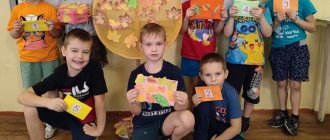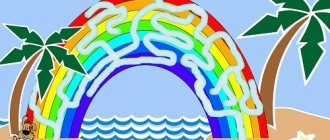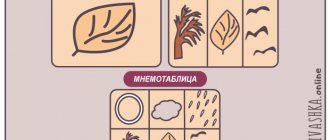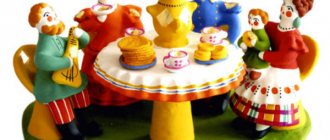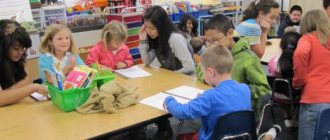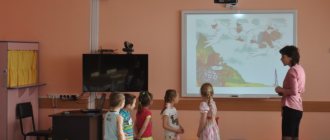Summary of GCD in the preparatory group with TRIZ elements
Summary of GCD in the preparatory group with TRIZ elements
Summary of GCD in the preparatory group with TRIZ elements Topic: “Rainbow of Knowledge”
Author: Andronova Marina Aleksandrovna, teacher of MKDOU Gavrilovo Posad kindergarten No. 1, Ivanovo region Description of the material: I offer you a summary of the final lesson in the preparatory group with TRIZ elements “Rainbow of Knowledge”. The material will be useful to kindergarten teachers. Integration of educational areas: “Speech development”, “Cognitive development”, “Artistic and aesthetic development”, “Social and communicative development”, “Physical development”. Goal: consolidation of previously studied material. Objectives: 1. Continue to form mental operations in children. 2. Develop speech, mental activity, the ability to express and justify your judgments. 3. Promote the formation of friendly relationships between children. Stages of the lesson: 1. Organizational moment (emotional mood for the lesson, fairy tale). 2. Motivation – setting goals and objectives for children (play). 3. The main one is direct work with children. 4. Reinforcing – conclusions, encouragement. Methods and techniques: verbal, game, practical. Techniques for managing children's activities: 1. Techniques for setting goals and motivating children's activities: a game situation. 2. Techniques for activating children’s activities in the process of educational activities: didactic games, logical thinking tasks. 3. Techniques for organizing children’s practical activities: conversation, demonstration, explanation. Didactic and handouts: presentation, poster - rainbow, pictures (fish, bird, animal), sheets with tasks for children, cards for the colors of the rainbow; pictures for the games “Good - Bad”, “Find the Extra Object”; sheets of purple colored paper, ball. PROGRESS of educational activities: Educator: Guys, I know one secret, it turns out that you are the smartest children in the world. Do you know why? (children's answers). That's right, because we worked with you a lot, we know a lot, we learned a lot. And now we will show all this to our guests. But before that, I want to tell you a fairy tale (at this time I turn on the music). Educator: Once upon a time there were guys in a rainbow country. They were all cheerful and hardworking. The girls are beautiful and kind at heart. The boys are strong, like heroes, and fair. And they had miracles in the rainbow land. Educator: What kind of miracles do you think there can be in the rainbow country? (children's answers) (a slide with a picture of a rainbow appears on the screen)
Educator: Look, what is this? (children's answers) This is a rainbow that appeared in the sky every time after rain. But trouble happened in the rainbow country: the miracle rainbow went out (the rainbow disappears on the screen) It was gone. The girls began to cry, and the boys began to console them. (Don’t cry, we’ll get a new rainbow) Educator: Children, let’s help us find the rainbow too? What magic words do you think will help us find the rainbow? (children’s answers) (“Every hunter wants to know where the pheasant sits”) Educator: Let’s all clearly pronounce these words together. Educator: Guys, each word in this counting rhyme means a specific color. How many colors does the rainbow have? Name the colors of the rainbow. (Children answer.) Educator: What sound does the word “every” begin with? etc. Educator: Well done, look at the model of the rainbow in front of us. We will complete tasks for every color of the rainbow and if we do everything right, what will happen? (children's answers) (a rainbow appears again). red stripe. “The world around us” Educator: Guys, what is the top color of the rainbow? (red) For the red color of our miracle rainbow to appear, look carefully at the pictures. (Crucian carp. Woodpecker. Fox.) Tell me, who is shown in these pictures? (children's answers) Let's play the game “Fish. Bird. Beast" Ball game "Fish. Bird. Beast" . Children stand in a circle. In the center is a teacher with a ball. Passing the ball to the children one by one, the teacher says: “Bird!” The one who received the ball must quickly name a bird. The players name animals and fish in the same way. Necessary condition: do not repeat yourself. Educator: And now we will solve riddles: 1. The centipede boasts: Am I not a beauty? All that’s left is a bone and a little red blouse. (Cherry) 2. This berry is easy to pick - After all, it grows low. Look under the leaves - There's a delicious one growing... (strawberries) 3. I'm red, I'm sour, I grew up in a swamp, I'm ripening under the snow. Children, who knows me? (Cranberry) 4. Here we are, berries, look, they look like small thimbles. We are all the color of dawn: Scarlet - vermilion. (Raspberry) Educator: Please tell me what all these riddles have in common? (berries) Educator: What color are these berries? (Red color) Educator: Is it possible to eat them? And what should you do before eating them? (children's answers) Educator: Well done! So you have found the red color of the rainbow! (red color appears on the poster) Guys, what is the second color of the rainbow? (Orange) Orange stripe. “Mathematics” Educator: And for the color orange, we will go to the country “Mathematics”. Educator: Sit down at the tables. Take sheets of paper in a box, there are dots with numbers there. You must connect the dots with lines 1 to 9. Educator: What did you get (Boat) Educator: Guys, I’ll tell you a riddle, but don’t say the answer out loud. This will be your secret! I held a small tail in my hand. You flew - I ran after you. (Balloon) Educator: Take sheets with geometric shapes. Find the answer in the drawing, color the answer with a pencil of the same color as the second color of the rainbow. Which shape did you color? Why? How did you guess? What color did you paint it? Why orange? Educator: Well done, and you completed this task. Now our rainbow has the color orange? (orange appears on the poster) What is the third color of the rainbow? (Yellow) Yellow stripe. “Bad deeds are good deeds” Educator: What do you think this is? (children's answers) To pass this stage you need to prove that you can distinguish between good and evil. Look and tell me where there are pictures with good deeds and deeds, and where with bad ones? (game “Good - Bad”) Educator: Explain why you consider these actions to be good and others to be bad? (children's answers) Educator: Now does our rainbow have a yellow color? (the color yellow appears on the poster) What is the fourth color of the rainbow? (Green) Green stripe. “Certificate” Now we will play the game “Rainbow”. Repeat after me. Physical education There is thunder and thunderstorm in the sky. Close your eyes! (Close your eyes with your hands) The rain has passed. The grass is shining, (Remove your hands from your eyes) There is a rainbow in the sky. (Draw an arc in the air) Quickly, quickly, Run out of the doors, (Calling movements) Barefoot on the grass, (Running in place) Jump straight into the sky. (Jump) Okay, okay! Along the rainbow, along the iris, (Clapping) Along a colored arc on one leg. (We stand on one leg) Down the rainbow astride, And to the ground somersault! (Sit down on the rug) (S. Marshak) Educator: What sound does the word RAINBOW begin with? (children's answers) What sound is this, a vowel or a consonant? (children's answers) Educator: I suggest you play the game “Clapping”. I will read Samuel Marshak’s poem “Rainbow - Arc”, and you will clap your hands if you hear words that contain the sound “r”. “RAINBOW-ARC” Spring sun with rain Together they build a rainbow - A seven-color semicircle From seven wide arcs. The sun and the rain don't have a single nail, And they built the Celestial Gate in no time. The rainbow arch blazed brightly, painted the grass, bloomed blue. Educator: Now come up with and name words with the sound [R]. Educator: Well done! So you have found the green color of the rainbow! (green color appears on the poster) Guys, what is the fifth color of the rainbow? (Blue) Blue stripe. “The fourth one is extra” Educator: In order for the blue stripe to appear, you need to complete the tasks correctly. Look at the pictures and tell me what is odd. Explain why you think so (game “Find the extra object”). Educator: Now does our rainbow have a blue color? (blue color appears on the poster) What is the sixth color of the rainbow? (Blue) Blue stripe. Game “On the contrary”, “What happens” Educator: And in order to find the blue color of the rainbow, I propose to play the game “On the contrary”. I will tell you words, and you must say its opposite meaning. High - low, Far - close Long - short Wide - narrow Thick - thin Hot - cold Sweet - sour, etc. Educator: The next game is “What happens.” I will show you cards of a certain color, and you must match the name of the color on the card - as many words - objects as possible. Green – grass, leaf, jacket... Red – coat, car... etc. (Each child selects words - objects to match the color) Educator: Well done! Now you have completed all the tasks well and found the blue color of the rainbow! (blue color appears on the poster) Guys, what color is the seventh stripe of the rainbow? (Purple) We just have to find the color purple. Purple stripe, “Origami Rainbow Birds” Educator: In front of you are sheets of colored paper. Why are they purple? (children's answers) Educator: That's right, we just have to find the color purple. Remember what word in the counting rhyme means purple? (pheasant) Educator: Who is pheasant? (bird). Let's now create a miracle - rainbow birds from colored purple paper (children make birds from colored paper) Educator: Children, did you like the birds? Have we found the color purple? (purple color appears on the poster) (children's answers) Result. Guys, have we found all the colors of the rainbow? (children's answers) What kind of rainbow did we get? (children's answers) Oh, look, the miracle of a rainbow is shining again in the rainbow country (a slide with a picture of a rainbow appears on the screen).
We helped return the miracle - the rainbow - to the inhabitants of the rainbow country. And now each of you has your own piece of our miracle - the rainbow - your rainbow purple birds. They will remind you of the wonderful rainbow you found. Well done! You were friendly and diligent! Always be like this and you will succeed! Reflection: This concludes our rainbow adventure. Always be friends, guys, help each other, this is the only way we will learn to create miracles! Both rainbow and real! And most importantly, smile more, because smiling will make everyone brighter! TO THE SONG “SMILE” THE CHILDREN GO TO THE GROUP.
We recommend watching:
Summary of educational activities for cognitive development in the preparatory group "Journey to the North" Summary of educational activities for children of the preparatory group "Modes of Transport" Summary of cognitive activities in the preparatory group on the topic "Reservoirs" Summary of educational activities in the preparatory group of a kindergarten using ICT on the topic: Sport
Similar articles:
Summary of a lesson in the preparatory group on the topic: Rules of conduct in kindergarten
Life safety lesson “Rules of safe behavior on water.” Preparatory group
LiveInternetLiveInternet
Sunday, September 15, 2013 22:25 + to quote book Summary of a lesson using the TRIZ method in the senior group on the topic: “The Four Elements.” Program content: Educational objectives: 1. Introduce children to the four elements of nature. 2. Give knowledge about their benefits and harms in human life. 3. Teach children to make assumptions, conclusions, put forward hypotheses, generalize, analyze. Developmental tasks: 1. Develop research abilities and skills. 2. Develop curiosity, cognitive activity 3. Develop memory, logical thinking, intelligence. 4. Enrich children’s vocabulary and introduce them to specific words. 5. Expand children's horizons. Educational objectives: 1. To cultivate accuracy and caution in work. 2. Cultivate attentiveness, observation, discipline. Motivation: Zhenya came to kindergarten with a bandaged finger. Children are wondering what happened? It turns out that the night before there was no light in the house, and Zhenya got burned while being near a candle. The teacher asks the children a question: (Is fire good or bad for a person). After listening to the children’s answers, the teacher suggests that in the near future they visit the room where experimental work usually takes place. Methods, techniques, technologies: Verbal, visual, problem situation, experimental activity, story, explanation, instructions from the teacher. Organization of children: Standing in a semicircle, sitting at tables, sitting opposite each other. Forms of work: Frontally, in pairs, subgroups. Vocabulary work: Landslide, earthquake, rockfall, minerals, monsoons, floods. Artistic word: Ecological anthem. Previous work: Games with water, sand, stones. Materials: posters, illustrations, paintings. Equipment for experiments: matches, a candle, a container with water, sailboats made of walnuts, a container with sand, a medical bulb, water in cups, watering cans, indoor flowers, green onions in the ground. In the mini-museum: collections of stones, flax herbariums, linen items, videos. Progress of the lesson: - Guys, do you remember how Zhenya came to kindergarten with his finger burned from a candle? (Yes) . — I promised you that I would show the room where they conduct experiments and experiments with various materials. Line up in pairs and we’ll go to the experimental laboratory. (Children enter a room where illustrations with different elements of nature are hung, with experimental tables, indoor plants, with green onions planted, and a mini-museum). — Guys, look what is shown in the paintings? (Fire, water, air, earth). — Come to these illustrations, stand in a semicircle. What do you think, after comparing different stories, is fire good or bad for a person? Children's answers. Good: It warms, illuminates, people cook food on it, it moves vehicles, for example, a steam locomotive, a balloon, etc., strong fire melts metal, people make metal objects. Bad: In a fire, you can get burned, burn, suffocate with carbon monoxide, a bright flash of fire can blind, and a nuclear flash can even instantly evaporate a person. The teacher offers - 5 seconds. watch a video about fire. (Children sit on chairs). - Now go to the first experimental table. Experience No. 1. (conducted by the teacher, children stand in a semicircle). Burning candle. Look how beautiful the mesmerizing tongue of flame is. Light comes from it, if I raise my hand to it, I feel warmth, but if I hold my hand over the flame for a long time, it will burn. The strip of paper will burn and the metal tray will become very hot - show. - Let's go to the next stand, where water is depicted. Guys, look carefully at the illustrations and answer, is water good or bad for all life on Earth? (Children answer). Good: Man consists of 80% water. A person can live without water for 3 days. Water is needed by plants and animals that we eat. We use water for laundry, washing floors and dishes. Fish live in water, which we eat as food and seafood. We love water travel and swimming in reservoirs. Bad: Floods inundate crops, human homes collapse, and animals die. Avalanches come down from the mountains, causing destruction and casualties, people choke in the water, drown, die from hypothermia and injuries. Heavy rains, also called monsoons, flood entire cities and rivers overflow their banks. The teacher offers - 5 seconds. watch a video about water (Children sitting on chairs). Experience No. 2. (children spend sitting at tables). Children are invited to drink a glass of water and talk about its qualities, about when they are most thirsty (hot, after meals, after sports games). Invite children to go to a natural corner and use a watering can to water indoor plants and green onions. Remind that a well-watered plant is healthy, the color is juicy, etc. (Children work in subgroups). (Children stand in a semicircle). - Now, guys, take a deep breath. Take a breath through your nose and release it into your palm. We don’t feel the air, but we feel it when we release a stream of air, it turns out to be a small breeze. Wind is the movement of air. Is wind good or bad? (Children's answers). Good: Refreshing in the heat, disperses rain clouds, moves sailing ships, turns mill blades. Bad: Strong wind interferes with rest, raises sand and snow storms, and a large wave at sea that overturns and sinks ships. (Hurricane wind destroys and carries fire, destroys buildings, uproots trees). - Look at the illustrations about the wind (seascapes; sand dunes; snow hummocks) Experiment No. 3. (conducted by children). — Children sit in pairs, opposite each other, at tables with containers of water and, with the help of exhalation (their little breeze), move sailboats to each other. Experience No. 4. (children spend sitting at tables). “With the help of medical syringes, you can see how sand dunes and snow hummocks form in nature. Children complete the task near their sand container. The teacher offers - 5 seconds. watch a video about the wind. - There is one more element left - Earth. Look at the illustrations: (Illustrations depicting gardens, vegetable beds, forest mushrooms and berries). Tell me, is land good or bad for humans? (Children's answers). Good: We see in the pictures that our Earth is beautiful at any time of the year. She feeds us: vegetables, fruits, berries, mushrooms, grain crops. Trees growing on the ground give us oxygen, we build houses, furniture, etc. from them. We wear linen products. The Earth contains minerals. (The teacher leads the children to illustrations depicting environmental disasters). Bad: Rockfalls, landslides, earthquakes injure people and even lead to death. — I propose to get acquainted with the exhibition of the mini-museum: flax herbarium, linen items, stones: quartz, spatula; coal, oil. Children look at it, pick it up, and compare it in terms of strength and hardness. — We got acquainted with the four elements of nature. Only a person's careful attitude and reasonable use of natural resources can turn them to his benefit and not to his detriment. — I propose to play a didactic attention game “Four Elements.” I remind you: Air - hands rise up. Earth-hands fall down. Fire - hands move up and down, up and down. Water - hands move left - right, left - right. “Children, disperse and stand freely throughout the hall, we will end our exciting journey with the “Ecological Hymn.” -Guys, where have we been today? (In the experimental laboratory). -Did you like the trip? (Yes, it was very interesting). -What elements did you meet? (Fire, water, air, earth). -What did you find difficult? (I couldn’t move the sand with a syringe; the breeze wasn’t strong). -What did you like most about our trip? (I liked exploring the water. And I got to water the houseplants and onions, because I was doing a good deed. I enjoyed looking at the fire when you did the experiment). -Zhenya, have you now remembered how to behave if there is a fire nearby, so as not to cause trouble? (Yes, you have to be very careful, because fire can be not only good). Guys, next time we will visit other laboratories and learn a lot of new and interesting things. You can apply the acquired knowledge in your games.
Series of messages "TRIZ":
Part 1 - GCD "Cognition". Familiarization with the environment “Fire is a friend, fire is an enemy”, using TRIZ elements Part 2 - Experience using the TRIZ method ... Part 9 - Consultations for educators “Method aimed at achieving an ideal result” (TRIZ). Part 10 — Master class Topic: “Application of TRIZ methods in the everyday life of a kindergarten” Part 11 — Summary of a lesson on the TRIZ method in the senior group on the topic: “The Four Elements.”
Tags:
triz
Cited 2 times Liked by: 1 user
Like share
0
Like
- 1
I liked the post - Quoted
- 0
Saved
- Add to quote book
- 0
Save to links
Liked1
0
